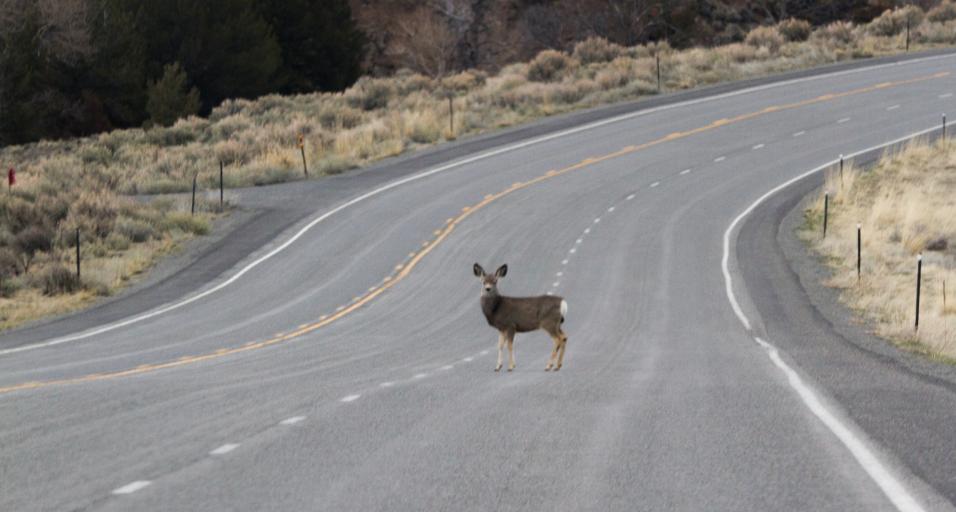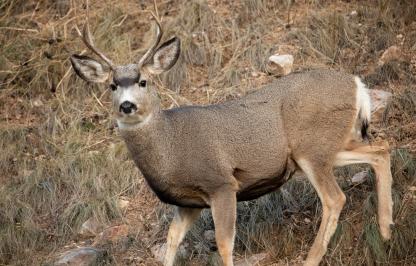Drivers on Wyoming roads have one thing in common - most have, or have nearly, hit a big game animal. Nearly 6,000 big game animals like deer, pronghorn, elk, moose, bighorn sheep and mountain goats die each year from collisions with vehicles on Wyoming’s highways and interstates. The Wyoming Game and Fish Department along with the Wyoming Department of Transportation is hoping to change those statistics with a new initiative to keep wildlife and drivers on the go. Wildlife Crossing focuses on raising funding and awareness for reducing wildlife-vehicle collisions.
“Our vision for all wildlife crossing projects is to ensure wildlife are able to easily and safely cross highways in order to access important seasonal habitats,” said Brian Nesvik, Game and Fish director. “We’re partnering with the Wyoming Department of Transportation to reduce collisions and design roads with wildlife in mind.”
In 2017, Game and Fish, WYDOT and wildlife conservation groups came together to form the Wyoming Wildlife and Roadways Initiative Team. In partnership, the team identified 240 opportunities statewide to take action for wildlife and motorist safety through a variety of roadway projects. Some projects are as expensive as wildlife over and underpasses or as localized as fencing and wildlife crossing signs.
The projects were priority ranked based on safety, biological issues and feasibility, boosting 10 to as the most significant or greatest need. Those include areas near Dubois, Cody, Meeteetese, Kaycee, Powder River, Kemmerer, Dry Piney, Sweetwater, Bates Hole and Halleck Ridge.
One of those projects — Dry Piney — is a 19-mile stretch of US 189 between La Barge and Big Piney with the most mule deer collisions in Wyoming. Both the Wyoming Game and Fish Commission and the Wyoming Transportation Commission contributed $1.25 million, and WYDOT was awarded a $14.5 million BUILD grant.
“This grant will enable us to continue our work on the Dry Piney project, which will help us reduce vehicle-wildlife collisions on our roads,” said WYDOT Director K. Luke Reiner. “This initiative is important to Wyoming because it will not only improve highway safety but also preserve natural wildlife movements.”
Seven to eight underpasses are planned to allow game to cross under the highway with the help of wildlife friendly fencing that will funnel deer and other wildlife to the crossing. The improvements are projected to reduce collisions by 85-90 percent.
Solving roadways problems for wildlife isn’t the simplest endeavor. Angi Bruce, Game and Fish deputy director says each site is unique and therefore has different potential solutions. With the help of movement data from collared animals, wildlife managers can see the exact places wildlife get hung up during seasonal and daily movements. This technology helps wildlife managers and road engineers pinpoint the needs and suggest the right solution for each road - and it’s not always underpasses and overpasses.
“There is a danger of over-simplifying the projects and the problem - wildlife over and underpasses don’t work everywhere and they are expensive,” Bruce said. “Each opportunity is unique and has different considerations to be successful, including private landowner buy-in, cost, social considerations, biology and geography. With these considerations and data in mind, Game and Fish and WYDOT can be the most strategic, responsible and collaborative with funding and resources.”
Because there are a spectrum of projects to help wildlife and drivers share the road safely, Wyoming citizens have many opportunities to get involved.
“People can reach out to their local Game and Fish biologist or WYDOT engineer to learn more about their local projects, donate money to statewide efforts and show their support with the Wyoming wildlife conservation license plate,” Bruce said.
The license plate directly funds wildlife conservation efforts, thanks to a bill passed by the 2018 Wyoming Legislature. The initial price of the plate is $150 with a $50 renewal fee each year, in addition to registration fees. Proceeds from sales and donations will help fund overpasses, underpasses, fencing and signage to prevent vehicle/animal collisions along wildlife migration corridors. For 2020, Gov. Mark Gordon has challenged Wyoming drivers to put 2,020 Conservation License Plates on the road..
“We’ve already seen tremendous support from the public for the wildlife conservation plate. The plate allows those who want to support wildlife conservation efforts in the state of Wyoming to do so because a portion of the plate proceeds go toward those activities,” Reiner said. “The people of Wyoming have always had a strong commitment to making this state better, and the wildlife conservation plate gives them the opportunity to help make a difference.”
Wildlife Crossings comes on the heels of Gov. Mark Gordon’s Migration Corridor Protection Executive Order.
“We’re proud to focus efforts on wildlife crossings, and it is one additional way we can utilize our science and data to support the seasonal migrations of wildlife,” Bruce said.
For more information on Wildlife Crossings and how the public can support wildlife visit: https://wgfd.wyo.gov/wildlifecrossing.
Game and Fish and WYDOT’s ‘Wildlife Crossing’ initiative to make roads safer for wildlife and drivers
Sara DiRienzo (307-777-4540)




